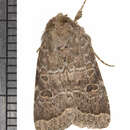Description
provided by Zookeys
Adults. Males and females of similar size (forewing length 11–17 mm). Vestiture of palpi, head, and thorax of long apically-forked or apically-serrated scales, sometimes with a slightly-raised central tuft near front of thorax. Head – Labial palpus porrect, apical segment about ½ as long as second segment. Frons rounded, covered with strap-like scales projecting over it from sides and top. Eye covered with surface hair. Male antenna biserrate (like toothed edge of a saw) to bipectinate (lateral processes mainly parallel sided like a feather) with lateral processes 0.5–4.0 × as long as central shaft. Female antenna filiform, setose ventrally. Thorax – Wings: Forewing ground color typically gray, brown, or orange; pattern variable, typically with reniform and orbicular spots with a pale or black outline, usually lower part or all of reniform spot filled with gray, which is darker than the ground color; postmedial line dentate or with inner element straight, outer element broken into series of dots on veins; subterminal line pale and sinuate in most species with dark wedges or shading along inner margin. Hindwing white to fuscous. Legs: Tibiae without spiniform setae. Tarsal segments 1–4 with three ventral rows of spiniform setae, and four ventral rows on tarsal segment 5. Abdomen – Base of abdomen without basal abdominal brushes. Eighth abdominal sternum of male with tuft of long setae on a short eversible coremata. Male genitalia – Uncus typically slender, slightly swollen mesially, tapered at apex to hook-like process. Valve broadest beyond middle, tapered to slight “neck” defining apical cucullus; sacculus more heavily sclerotized dorsally than ventrally with dorsal part crenulate and setose in some species; clasper a sclerotized plate in middle of valve distal to sacculus from which arises a long, heavily-sclerotized ampulla projecting posterodorsally, extending almost to, or beyond, dorsal margin of valve; ampulla centrally swollen in most species; digitus arising from large sclerotized plate in middle of valve, tapered posterolaterally into heavily-sclerotized pointed or blunt process projecting below ventral margin of valve at neck of cucullus; cucullus covered with long inward-projecting setae and with no defined apical corona. Vesica usually twisted or coiled above base with numerous pouches or diverticula basally and subbasally; a long, heavily-sclerotized basal or subbasal cornutus in most species; vesica 1–2 × as long as aedeagus. Female genitalia – Corpus bursae thin and membranous, rounded or oval, without obvious signa. Appendix bursae typically with one or two short coils. Ductus bursae variably sclerotized, usually about as long as corpus bursae. Abdominal segment eight about 2 × as long as wide; anterior apophyses 0.5–2.0 × as long as abdominal segment eight; posterior apophyses folding near middle, about 2.5 × as long as anterior apophyses. Ovipositor telescoping and projecting well beyond end of abdomen in most specimens. Anal papillae long and tapered, 0.5–1.0 × as long as abdominal segment eight; anal papillae lightly sclerotized, setae mainly confined to apical area.
- license
- cc-by-3.0
- copyright
- J. Donald Lafontaine, J. Bruce Walsh, Clifford D. Ferris
- bibliographic citation
- Lafontaine J, Walsh J, Ferris C (2014) A revision of the genus Protorthodes McDunnough with descriptions of a new genus and four new species (Lepidoptera, Noctuidae, Noctuinae, Eriopygini) ZooKeys 421: 139–179
- author
- J. Donald Lafontaine
- author
- J. Bruce Walsh
- author
- Clifford D. Ferris

